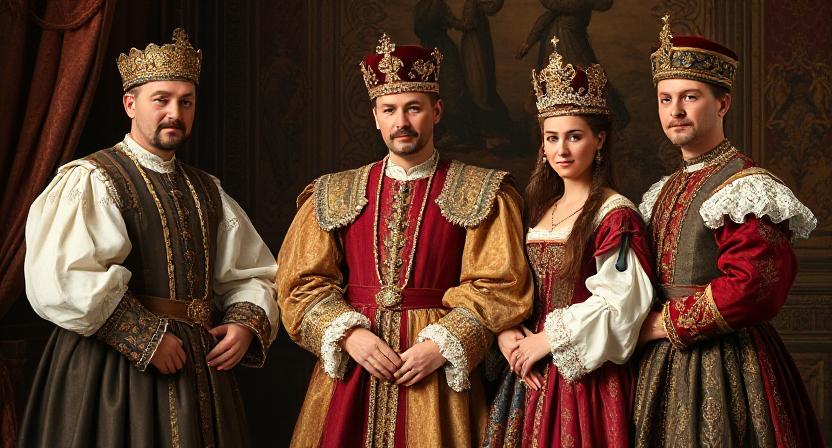Russian history is a tapestry of grandeur, tradition, and transformation. One of the most fascinating aspects of this rich heritage is the clothing of the Russian royalty in the 16th century. During this time, known as the height of the Middle Ages in Russia, fashion was not just a matter of style — it was a symbol of power, religion, and status. The imperial Russian garments worn by the nobility and royalty reflected the grandeur of the Tsardom and the deep cultural connections with Byzantium and the East.
In this article, we’ll explore the 16th-century imperial Russia, focusing specifically on Russian royalty clothes in the Middle Ages, their symbolism, materials, and the social codes they represented.
The Political and Cultural Background of 16th Century Imperial Russia
The 16th century was a transformative era for Russia. It marked the rise of Ivan IV, better known as Ivan the Terrible, who was crowned the first Tsar of Russia in 1547. This momentous event symbolized Russia’s emergence as a centralized empire. With imperial ambitions came the desire to showcase dominance — and royal fashion played a central role in displaying wealth and divine right.
Under Ivan IV and other nobles of the time, fashion became not just about beauty but a manifestation of power and spiritual authority. Russian royalty clothes in the Middle Ages thus combined Eastern opulence with Orthodox Christian modesty.
H2: Elements of Russian Royalty Clothes in the Middle Ages
Russian royal garments of the 16th century were carefully crafted, luxurious, and deeply symbolic. Let’s break down the key components of royal clothing during this period.
H3: 1. The Kaftan
The kaftan was a fundamental piece of clothing worn by both men and women of the Russian aristocracy. It was a long robe, often made of imported silk, brocade, or velvet, and richly decorated with gold embroidery, pearls, and fur trims.
Royal kaftans were distinguished by their intricate detailing and use of rare fabrics from Persia, China, and the Ottoman Empire. For royalty, a kaftan wasn’t just a garment—it was a statement of imperial connection and affluence.
H3: 2. The Sarafan (For Women)
Royal women in 16th-century Russia often wore the sarafan, a long, sleeveless dress worn over a shirt. While peasants wore simple versions, noblewomen and queens (Tsarinas) wore heavily embroidered sarafans adorned with precious stones, pearls, and gold threads.
The sarafan was frequently paired with a kokoshnik, a traditional headdress which signified a woman’s marital status and social rank.
H3: 3. The Shuba (Fur Coat)
Russia’s harsh winters required insulation, and the shuba — a long, fur-lined coat — was a staple in royal wardrobes. Made from sable, ermine, or fox fur, the shuba was a mark of nobility. The more exotic the fur, the higher the status of the wearer.
Fur was not only practical but also deeply symbolic. Sable, for example, was reserved for the Tsar and highest-ranking boyars (nobles). Wearing fur was a privilege, governed by law and custom.
H3: 4. Headwear and Crowns
Russian royalty wore elaborate headgear to demonstrate their divine right to rule. Male royals donned monomakhs — fur-trimmed crowns or hats that symbolized Byzantine heritage. The most famous of these is the Monomakh’s Cap, a crown passed down through generations of Russian tsars.
Female royalty wore the kokoshnik or the so-called “shapka”, often made with gold, pearls, and fine lace. These headdresses were tall and elaborately decorated, creating an awe-inspiring presence at court and religious ceremonies.
H3: 5. Jewelry and Accessories
Jewelry was not merely decorative — it was a sign of favor from the Tsar or Church. Russian royalty in the 16th century adorned themselves with:
-
Crosses (symbolizing faith and divine protection)
-
Necklaces and brooches made from amber, turquoise, sapphires, and diamonds
-
Belts with gold buckles and sacred engravings
-
Icon pendants carried for religious protection
Royal accessories were handmade by some of the most skilled craftsmen in the Tsardom and often imported from Eastern empires and Western Europe.
H2: The Symbolism Behind Russian Royalty Clothes
Every aspect of a royal’s outfit had meaning in imperial Russia. From the colors to the fabrics, nothing was random.
H3: 1. Color Symbolism
-
Red: Represented beauty, fertility, and power. Red (or “krasny” in old Russian) was synonymous with “beautiful”.
-
Gold: Signified divinity and the favor of God.
-
Blue and Silver: Symbolized purity and celestial protection.
The use of deep, rich colors conveyed authority and the sacred nature of the royal position. Royal garments were intentionally designed to evoke religious awe.
H3: 2. Religious Influence on Fashion
Orthodox Christianity had a profound influence on royal fashion. Modesty and sanctity were emphasized. Even the most luxurious garments covered the body fully. Cloaks, long sleeves, and covered heads were the norm.
Clothing was also worn for religious rituals and church ceremonies, with specific garments reserved only for holy days or coronations. Embroidered icons and crosses were often stitched directly into the fabric.
H2: The Court Dress Code and Sumptuary Laws
In the 16th century, sumptuary laws governed who could wear what. Only the Tsar, his immediate family, and top boyars were allowed to wear certain furs, colors, and decorations.
These laws were intended to preserve class distinctions and prevent the merchant class from imitating nobility. They also ensured that royal fashion retained its power to awe and distinguish.
Court ceremonies had strict dress codes. Ambassadors from other nations often documented the splendor of Russian court fashion, remarking on the shimmering gold threads, heavy jewels, and grandeur unmatched in Europe.
H2: Legacy of 16th Century Russian Royal Fashion
The legacy of 16th-century imperial Russian fashion continues to influence modern Russian culture and design. Designers today still draw inspiration from:
-
Kokoshniks, seen in fashion shows and weddings
-
Embroidered patterns resembling royal motifs
-
Use of fur, gold accents, and rich fabrics
Moreover, historical dramas and museums in Russia keep the memory alive through accurate recreations of royal garments. These clothes offer a tangible connection to the past and highlight the grandeur of medieval Russian royalty.
Conclusion
The 16th century imperial Russia was an era of transformation, where Russian royalty clothes in the Middle Ages were more than fashion — they were a powerful symbol of divine right, cultural identity, and political authority. From luxurious kaftans and fur-trimmed shubas to jewel-encrusted crowns and religiously inspired accessories, royal clothing reflected the spiritual and imperial vision of the Tsardom.
By understanding the clothes of Russian royalty during this era, we gain deeper insight into the values, artistry, and power structures of medieval Russia. The magnificence of these garments continues to capture the imagination and serve as a reminder of the opulent and sacred world of the Russian court.





